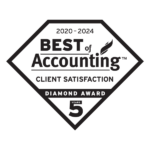How can Chief Financial Officers (CFO) prepare for tariffs in 2025?
This article is part of a series examining the key challenges and best practices that today’s CFOs face as they navigate tariff uncertainty in 2025. Download the full guide, “The CFO’s Guide to Tariff Uncertainty in 2025”, here.
A CFO’s job is never easy. Managing a company’s financial strategy, cash flow, and risk are difficult tasks even in stable times. As we move into 2025, CFOs are faced with a new, challenging landscape characterized by increasing uncertainty around tariffs.
The unpredictable trade policy adds layers of complexity to the CFO role, making it crucial for financial leaders to be forward-thinking, adaptable, and prepared to manage multiple financial risks. Companies must be ready to take both preventative and reactive measures swiftly, in response to tariff-related risks. Agility will be key in mitigating the financial impact, and CFOs need to be more strategic than ever.
We know that many companies plan to pass on the cost of new or higher tariffs to their customers in an attempt to maintain targeted margins. Downstream businesses that rely on raw materials and other goods from these companies will, in-turn, be directly impacted by tariffs.
Here are the five things I’m advising CFOs to do now:
- Reassess Enterprise Risk Management (ERM): CFOs should consider updating their enterprise risk management framework to account for tariff-related risks. Current risks might not have been identified as significant risks the last time the analysis was done. Given the current climate, identifying areas of exposure and integrating these into broader risk assessments will allow companies to stay ahead of potential disruptions.
- Conduct a Supply Chain Risk Assessment: A thorough assessment of supply chain risks is essential. It’s crucial for CFOs to evaluate their supply chain dependencies and understand where disruptions could occur. CFOs should evaluate potential vulnerabilities and develop alternative sourcing plans where necessary to minimize dependency on high-tariff regions. Companies need to pinpoint their tariff exposure as early as possible. Understanding which goods or services are most likely to be affected and being prepared with a rapid response strategy can give businesses an edge in mitigating risks.
- Develop an Agile Pricing Strategy in Response to Uncertainty: CFOs should assess their pricing strategies carefully to ensure competitiveness while managing rising costs. This involves building flexible pricing models that account for potential cost increases, conducting scenario analyses to prepare for different tariff outcomes, and closely monitoring competitor pricing strategies to stay competitive. Dynamic pricing tools can help automate real-time adjustments, and transparent communication with customers about price changes can assist in preserving trust and long-term relationships. Ultimately, agility in pricing will enable companies to swiftly respond to fluctuating tariffs, ensuring financial resilience and strategic positioning in the market.
- Monitor Forecasts and Budgets for Increased Uncertainty: CFOs should continuously monitor forecasts and budgets to account for the heightened uncertainty surrounding tariffs. A sensitivity analysis can help assess how various tariff changes would impact costs, revenues, and overall profitability. CFOs should also ensure that their budgets are flexible enough to accommodate unexpected cost increases or supply chain disruptions and consider establishing contingency reserves within the budget to manage unforeseen expenses. By building in flexibility and constantly re-evaluating projections, companies can better prepare for and swiftly adapt to tariff fluctuations, ensuring financial stability amidst uncertainty.
- Build Scenario Plans: Scenario planning is a crucial tool for CFOs to navigate tariff uncertainty, enabling businesses to prepare for a range of possible outcomes. By modeling different tariff scenarios, CFOs can assess how each situation would impact costs, supply chains, and profitability. This approach helps companies to identify their vulnerabilities and opportunities, allowing them to develop contingency plans for various tariff levels. Once scenarios are developed, companies can create actionable strategies, such as adjusting pricing, diversifying suppliers, or reallocating resources. By anticipating multiple possibilities, businesses can remain agile and better equipped to protect margins and market position.
At this point, no one can predict with certainty which goods will be impacted by tariffs and to what extent. This unpredictability adds complexity to the CFO role, as companies must prepare for a variety of possible outcomes and downstream effects. CFOs should remain proactive and agile, ensuring that their businesses can respond to any new tariffs or trade policy changes swiftly and strategically.
If you’d like to learn more about how Schneider Downs’ CFO Services team can assist in navigating these uncertainties, please contact us.
Other related articles in our series:
- Why CFOs Must Build Scenario Plans and Be Ready to Pivot
- Why CFOs Should Lead the Charge on Supply Chain Risk Assessments
- Why CFOs Need Agile Pricing Models
- The CFOs Role in Agile Forecasting and Margin Protection
- The Case for Integrating Tariff Risk into Enterprise Risk Management (ERM)
About Schneider Downs Managed Accounting Services
Schneider Downs Managed Accounting Services provide as-needed, part-time or full-time support for your accounting and finance needs. Focused on providing accounting leadership and support services to businesses that either have limited resources or wish to supplement their existing resources with additional technical expertise, Schneider Downs Managed Accounting Services can help you achieve your goals.
For more information visit our Schneider Downs Managed Accounting Services page.
Related Posts
- August Investment Corner – Crypto Week in Review
- The CFO’s Guide to Tariff Uncertainty in 2025: Why CFOs Should Lead the Charge on Supply Chain Risk Assessments
- The CFO’s Guide to Tariff Uncertainty in 2025: The CFO’s Role in Agile Forecasting and Margin Protection
- The CFO’s Guide to Tariff Uncertainty in 2025: Why CFOs Must Build Scenario Plans and Be Ready to Pivot





